Metro areas added nearly 3.2 million people between 2023 and 2024, led by overseas arrivals that outweighed domestic departures, the Census Bureau says.
The population in U.S. metropolitan areas grew faster than the nation as a whole between July 1, 2023, and July 1, 2024, rising almost 3.2 million, or about 1.1 percent, to reach 293.9 million. The national population increased nearly 1 percent to a little more than 340 million, according to the U.S. Census Bureau.
“Increasingly, population growth in metro areas is being shaped by international migration,” said Kristie Wilder, a demographer in the Census Bureau’s Population Division. She noted that births still add people, but higher net international migration is offsetting ongoing net domestic outmigration.
Net international migration contributed nearly 2.7 million residents to metro areas, up from 2.2 million the year before. Natural increase—births minus deaths—added about 600,000.
Key facts from the latest data revealed that 60 percent of individual metro areas experienced “natural increase” and approximately 59 percent had net domestic in-migration—though U.S. metro areas overall experienced net domestic outmigration.
Of the 10 fastest-growing metro areas year to year, nine were in the South and one was in the West. The two fastest-growing metros were both located in Florida. Seven of the 10 fastest-growing micro areas (populations of 10,000 to 49,999) were in the South, with the two fastest growing over the period located in Georgia and Florida.
Nearly 90 percent of the nation’s 387 metro areas gained residents, up from 82 percent the previous year. Places that lost population during the pandemic, including New York-Newark-Jersey City, Washington-Arlington-Alexandria, and San Francisco-Oakland-Fremont, returned to growth.
By sheer numbers, the largest metro gains were New York-Newark-Jersey City (213,403), Houston-Pasadena-The Woodlands (198,171), Dallas-Fort Worth-Arlington (177,922), Miami-Fort Lauderdale-West Palm Beach (123,471), and Washington-Arlington-Alexandria (90,608).
Measured by growth rate, the leaders were Ocala, Fla., 4 percent; Panama City-Panama City Beach, 3.8 percent; Myrtle Beach-Conway-North Myrtle Beach, 3.8 percent; Lakeland-Winter Haven, Fla., 3.5 percent; and Provo-Orem-Lehi, Utah, 3 percent.
Counties showed a similar pattern: 65.3 percent of the nation’s 3,144 counties grew in population. Large counties, defined as those with more than 100,000 residents, grew an average 1.1 percent, while the smallest counties on average lost residents.
By Chase Smith







